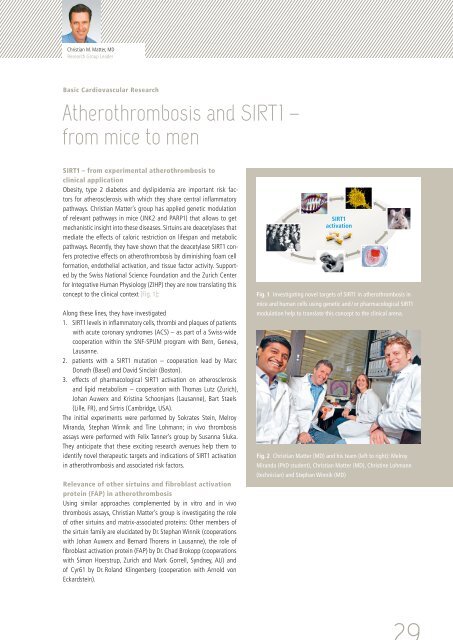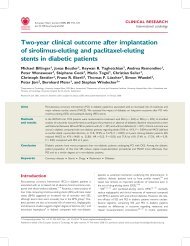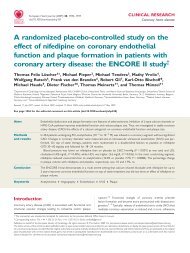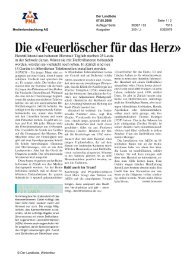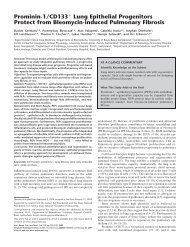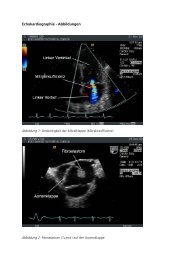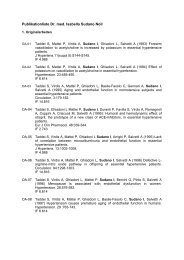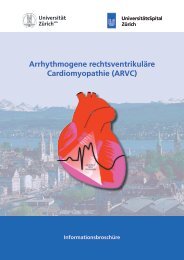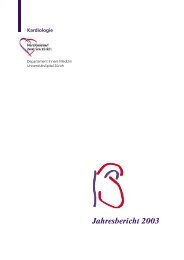Jahresbericht der Klinik - Klinik für Kardiologie - UniversitätsSpital ...
Jahresbericht der Klinik - Klinik für Kardiologie - UniversitätsSpital ...
Jahresbericht der Klinik - Klinik für Kardiologie - UniversitätsSpital ...
Erfolgreiche ePaper selbst erstellen
Machen Sie aus Ihren PDF Publikationen ein blätterbares Flipbook mit unserer einzigartigen Google optimierten e-Paper Software.
Christian M. Matter, MD<br />
Research Group Lea<strong>der</strong><br />
Basic Cardiovascular Research<br />
Atherothrombosis and SIRT1 –<br />
from mice to men<br />
SIRT1 – from experimental atherothrombosis to<br />
clinical application<br />
Obesity, type 2 diabetes and dyslipidemia are important risk factors<br />
for atherosclerosis with which they share central inflammatory<br />
pathways. Christian Matter’s group has applied genetic modulation<br />
of relevant pathways in mice (JNK2 and PARP1) that allows to get<br />
mechanistic insight into these diseases. Sirtuins are deacetylases that<br />
mediate the effects of caloric restriction on lifespan and metabolic<br />
pathways. Recently, they have shown that the deacetylase SIRT1 confers<br />
protective effects on atherothrombosis by diminishing foam cell<br />
formation, endothelial activation, and tissue factor activity. Supported<br />
by the Swiss National Science Foundation and the Zurich Center<br />
for Integrative Human Physiology (ZIHP) they are now translating this<br />
concept to the clinical context [Fig. 1]:<br />
Along these lines, they have investigated<br />
1. SIRT1 levels in inflammatory cells, thrombi and plaques of patients<br />
with acute coronary syndromes (ACS) – as part of a Swiss-wide<br />
cooperation within the SNF-SPUM program with Bern, Geneva,<br />
Lausanne.<br />
2. patients with a SIRT1 mutation – cooperation lead by Marc<br />
Donath (Basel) and David Sinclair (Boston).<br />
3. effects of pharmacological SIRT1 activation on atherosclerosis<br />
and lipid metabolism – cooperation with Thomas Lutz (Zurich),<br />
Johan Auwerx and Kristina Schoonjans (Lausanne), Bart Staels<br />
(Lille, FR), and Sirtris (Cambridge, USA).<br />
The initial experiments were performed by Sokrates Stein, Melroy<br />
Miranda, Stephan Winnik and Tine Lohmann; in vivo thrombosis<br />
assays were performed with Felix Tanner’s group by Susanna Sluka.<br />
They anticipate that these exciting research avenues help them to<br />
identify novel therapeutic targets and indications of SIRT1 activation<br />
in atherothrombosis and associated risk factors.<br />
Relevance of other sirtuins and fibroblast activation<br />
protein (FAP) in atherothrombosis<br />
Using similar approaches complemented by in vitro and in vivo<br />
thrombosis assays, Christian Matter’s group is investigating the role<br />
of other sirtuins and matrix-associated proteins: Other members of<br />
the sirtuin family are elucidated by Dr. Stephan Winnik (cooperations<br />
with Johan Auwerx and Bernard Thorens in Lausanne), the role of<br />
fibroblast activation protein (FAP) by Dr. Chad Brokopp (cooperations<br />
with Simon Hoerstrup, Zurich and Mark Gorrell, Syndney, AU) and<br />
of Cyr61 by Dr. Roland Klingenberg (cooperation with Arnold von<br />
Eckardstein).<br />
SIRT1<br />
activation<br />
Fig. 1 Investigating novel targets of SIRT1 in atherothrombosis in<br />
mice and human cells using genetic and / or pharmacological SIRT1<br />
modulation help to translate this concept to the clinical arena.<br />
Fig. 2 Christian Matter (MD) and his team (left to right): Melroy<br />
Miranda (PhD student), Christian Matter (MD), Christine Lohmann<br />
(technician) and Stephan Winnik (MD)


